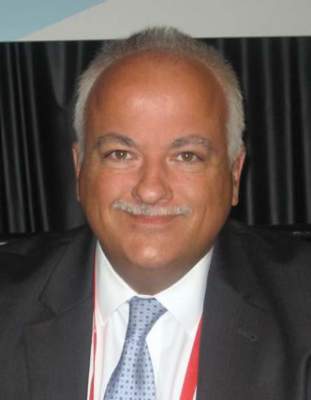User login
SAN FRANCISCO – Implantation of the novel DREAMS 2G sirolimus-eluting absorbable metal scaffold in patients with de novo coronary lesions was feasible and had favorable safety and performance outcomes at 6 months in the BIOSOLVE-II trial.
The findings of the prospective, nonrandomized, first-in-human trial suggest that the DREAMS 2G device – made from magnesium alloy with an absorption time of 12 months – could serve as an alternative to absorbable polymeric scaffolds for the treatment of obstructive coronary disease, Dr. Michael Haude of Medical Clinic I, Städtische Kliniken Neuss, Germany, reported at the Transcatheter Cardiovascular Therapeutics annual meeting.
In 120 patients with coronary target lesions who completed the trial and follow-up, the mean in-segment late lumen loss at 6 months – the primary endpoint of the study – was 0.27 mm, and in-scaffold late lumen loss was 0.44 mm. Discernable vasomotion was documented in 80% of a subgroup of 25 patients, he said at the meeting, which was sponsored by the Cardiovascular Research Foundation.
Among patients who underwent additional assessment, intravascular ultrasound showed preservation of the scaffold area (mean of 6.24 mm2 post procedure vs. 6.21 mm2 at 6 months) with a low mean neointimal area (0.08 mm2). No intraluminal mass was detected on optical coherence tomography, he noted.
Four patients (3%) experienced target lesion failure, and one died from cardiac death.
Periprocedural myocardial infarction occurred in one patient, and clinically driven target lesion revascularization was required in two patients (1.7%).
No definite or probable scaffold thrombosis was observed, Dr. Haude said.
Study subjects were enrolled during October 2013–May 2015 at centers in Belgium, Brazil, Denmark, Germany, Singapore, Spain, Switzerland, and the Netherlands. All had stable or unstable angina or documented silent ischemia and no more than two de novo lesions with a reference vessel diameter between 2.2 and 3.7 mm. The results were published online concurrently with Dr. Haude’s presentation (Lancet. 2015 Oct 12. doi:10.1016/S0140-6736[15]00447-X)
The findings demonstrate improved lumen loss with the DREAMS 2G device, compared with precursor devices, he said.
“If we compare this to the data that we have for the previous version, the bare version of the magnesium absorbable scaffold, the in-segment lumen loss was 0.83. That went down by 37% to the version with the paclitaxel elusion at 0.52, and then it decreased again by 48% to 0.27 ... without a single stent thrombosis case,” he said.
Absorbable metal scaffolds offer good radial strength, low acute recoil, and high compliance to the vessel geometry. Also, they can be implanted via a single step inflation, and thus can be implanted in a way similar to that of a permanent metal stent, he noted.
They can also be electropolished, which provides softer, round edges that allow for improved trackability and deliverability, he said, noting that the magnesium alloy stent provides the strength of metal, but also provides a potential long-term benefit with its ability to be absorbed over time.
Though limited by the nonrandomized trial design and lack of direct comparison with other permanent stents or scaffolds, as well as by the inclusion of only patients with straightforward de novo lesions and uncertainty about ideal follow-up time, DREAMS 2G offers a potential alternative to polymeric absorbable scaffolds, which are currently the scaffolds that are commercially available , Dr. Haude said.
BIOSOLVE-II was funded by Biotronik AG. Dr. Haude received study grants and lecture fees from Biotronik, Abbott Vascular, Cardiac dimensions, Medtronic, Volcano, and Lilly, as well as consulting fees/honoraria from Biotronik AG.
SAN FRANCISCO – Implantation of the novel DREAMS 2G sirolimus-eluting absorbable metal scaffold in patients with de novo coronary lesions was feasible and had favorable safety and performance outcomes at 6 months in the BIOSOLVE-II trial.
The findings of the prospective, nonrandomized, first-in-human trial suggest that the DREAMS 2G device – made from magnesium alloy with an absorption time of 12 months – could serve as an alternative to absorbable polymeric scaffolds for the treatment of obstructive coronary disease, Dr. Michael Haude of Medical Clinic I, Städtische Kliniken Neuss, Germany, reported at the Transcatheter Cardiovascular Therapeutics annual meeting.
In 120 patients with coronary target lesions who completed the trial and follow-up, the mean in-segment late lumen loss at 6 months – the primary endpoint of the study – was 0.27 mm, and in-scaffold late lumen loss was 0.44 mm. Discernable vasomotion was documented in 80% of a subgroup of 25 patients, he said at the meeting, which was sponsored by the Cardiovascular Research Foundation.
Among patients who underwent additional assessment, intravascular ultrasound showed preservation of the scaffold area (mean of 6.24 mm2 post procedure vs. 6.21 mm2 at 6 months) with a low mean neointimal area (0.08 mm2). No intraluminal mass was detected on optical coherence tomography, he noted.
Four patients (3%) experienced target lesion failure, and one died from cardiac death.
Periprocedural myocardial infarction occurred in one patient, and clinically driven target lesion revascularization was required in two patients (1.7%).
No definite or probable scaffold thrombosis was observed, Dr. Haude said.
Study subjects were enrolled during October 2013–May 2015 at centers in Belgium, Brazil, Denmark, Germany, Singapore, Spain, Switzerland, and the Netherlands. All had stable or unstable angina or documented silent ischemia and no more than two de novo lesions with a reference vessel diameter between 2.2 and 3.7 mm. The results were published online concurrently with Dr. Haude’s presentation (Lancet. 2015 Oct 12. doi:10.1016/S0140-6736[15]00447-X)
The findings demonstrate improved lumen loss with the DREAMS 2G device, compared with precursor devices, he said.
“If we compare this to the data that we have for the previous version, the bare version of the magnesium absorbable scaffold, the in-segment lumen loss was 0.83. That went down by 37% to the version with the paclitaxel elusion at 0.52, and then it decreased again by 48% to 0.27 ... without a single stent thrombosis case,” he said.
Absorbable metal scaffolds offer good radial strength, low acute recoil, and high compliance to the vessel geometry. Also, they can be implanted via a single step inflation, and thus can be implanted in a way similar to that of a permanent metal stent, he noted.
They can also be electropolished, which provides softer, round edges that allow for improved trackability and deliverability, he said, noting that the magnesium alloy stent provides the strength of metal, but also provides a potential long-term benefit with its ability to be absorbed over time.
Though limited by the nonrandomized trial design and lack of direct comparison with other permanent stents or scaffolds, as well as by the inclusion of only patients with straightforward de novo lesions and uncertainty about ideal follow-up time, DREAMS 2G offers a potential alternative to polymeric absorbable scaffolds, which are currently the scaffolds that are commercially available , Dr. Haude said.
BIOSOLVE-II was funded by Biotronik AG. Dr. Haude received study grants and lecture fees from Biotronik, Abbott Vascular, Cardiac dimensions, Medtronic, Volcano, and Lilly, as well as consulting fees/honoraria from Biotronik AG.
SAN FRANCISCO – Implantation of the novel DREAMS 2G sirolimus-eluting absorbable metal scaffold in patients with de novo coronary lesions was feasible and had favorable safety and performance outcomes at 6 months in the BIOSOLVE-II trial.
The findings of the prospective, nonrandomized, first-in-human trial suggest that the DREAMS 2G device – made from magnesium alloy with an absorption time of 12 months – could serve as an alternative to absorbable polymeric scaffolds for the treatment of obstructive coronary disease, Dr. Michael Haude of Medical Clinic I, Städtische Kliniken Neuss, Germany, reported at the Transcatheter Cardiovascular Therapeutics annual meeting.
In 120 patients with coronary target lesions who completed the trial and follow-up, the mean in-segment late lumen loss at 6 months – the primary endpoint of the study – was 0.27 mm, and in-scaffold late lumen loss was 0.44 mm. Discernable vasomotion was documented in 80% of a subgroup of 25 patients, he said at the meeting, which was sponsored by the Cardiovascular Research Foundation.
Among patients who underwent additional assessment, intravascular ultrasound showed preservation of the scaffold area (mean of 6.24 mm2 post procedure vs. 6.21 mm2 at 6 months) with a low mean neointimal area (0.08 mm2). No intraluminal mass was detected on optical coherence tomography, he noted.
Four patients (3%) experienced target lesion failure, and one died from cardiac death.
Periprocedural myocardial infarction occurred in one patient, and clinically driven target lesion revascularization was required in two patients (1.7%).
No definite or probable scaffold thrombosis was observed, Dr. Haude said.
Study subjects were enrolled during October 2013–May 2015 at centers in Belgium, Brazil, Denmark, Germany, Singapore, Spain, Switzerland, and the Netherlands. All had stable or unstable angina or documented silent ischemia and no more than two de novo lesions with a reference vessel diameter between 2.2 and 3.7 mm. The results were published online concurrently with Dr. Haude’s presentation (Lancet. 2015 Oct 12. doi:10.1016/S0140-6736[15]00447-X)
The findings demonstrate improved lumen loss with the DREAMS 2G device, compared with precursor devices, he said.
“If we compare this to the data that we have for the previous version, the bare version of the magnesium absorbable scaffold, the in-segment lumen loss was 0.83. That went down by 37% to the version with the paclitaxel elusion at 0.52, and then it decreased again by 48% to 0.27 ... without a single stent thrombosis case,” he said.
Absorbable metal scaffolds offer good radial strength, low acute recoil, and high compliance to the vessel geometry. Also, they can be implanted via a single step inflation, and thus can be implanted in a way similar to that of a permanent metal stent, he noted.
They can also be electropolished, which provides softer, round edges that allow for improved trackability and deliverability, he said, noting that the magnesium alloy stent provides the strength of metal, but also provides a potential long-term benefit with its ability to be absorbed over time.
Though limited by the nonrandomized trial design and lack of direct comparison with other permanent stents or scaffolds, as well as by the inclusion of only patients with straightforward de novo lesions and uncertainty about ideal follow-up time, DREAMS 2G offers a potential alternative to polymeric absorbable scaffolds, which are currently the scaffolds that are commercially available , Dr. Haude said.
BIOSOLVE-II was funded by Biotronik AG. Dr. Haude received study grants and lecture fees from Biotronik, Abbott Vascular, Cardiac dimensions, Medtronic, Volcano, and Lilly, as well as consulting fees/honoraria from Biotronik AG.
At TCT 2015
Key clinical point: Implantation of the novel DREAMS 2G sirolimus-eluting absorbable metal scaffold in patients with de novo coronary lesions was feasible and had favorable safety and performance outcomes at 6-months in the BIOSOLVE II trial.
Major finding: The mean in-segment late lumen loss at 6 months – the primary endpoint of the study – was 0.27 mm, compared with 0.83 mm for a bare metal precursor.
Data source: The prospective, nonrandomized, multicenter BIOSOLVE II trial of 120 patients.
Disclosures: BIOSOLVE II was funded by Biotronik AG. Dr. Haude received study grants and lecture fees from Biotronik, Abbott Vascular, Cardiac dimensions, Medtronic, Volcano, and Lilly, as well as consulting fees/honoraria from Biotronik AG.

